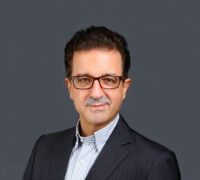
6 things your inner child can do for you
Discover how reconnecting with your inner child can boost creativity, resilience, and courage, turning curiosity into professional strengths....

by Richard Roi Published July 21, 2025 in Talent • 6 min read
The CFO is no longer just the company’s financial steward. As the role has expanded to encompass strategy, operations, governance, and long-term value, today’s CFO often resembles a chief architect: shaping the future of the business as much as stewarding its finances.
This profound shift in the mandate is rapidly changing the career paths for aspiring CFOs as well as for CFOs aspiring to take on the chief executive role. More are moving into the chief executive role, reflecting how boards, and sometimes the executives themselves, now view the CFO as a natural successor. Data from executive search firm Heidrick & Struggles shows that about one-third of FTSE 100 CEOs have previously served as CFOs, up from 21% in 2019. According to 2023 research from Crist Kolder Associates, 8.4% of CEOs at Fortune 500 and S&P 500 companies were promoted from CFO roles, up from 5.8% a decade earlier.
For boards, the move carries an inherent logic. CFOs bring deep financial acumen and operational oversight and will be accustomed to boardroom exposure. But there’s a crucial nuance often missed in this narrative: not all CFOs are the same.
Many so-called CFO-to-CEO transitions involve “non-traditional” CFOs. These are generalist executives placed in the CFO seat to bring a different focus to the finance leader role or to gain valuable experience to position them for eventual succession to the top job.
This article is written for the traditional CFOs, who’ve spent most of their careers in finance and now want the chance to take overall strategic control of a company. For this group, the path to CEO doesn’t just involve winning a promotion. It means transforming how they view their role and the range of new capabilities they need to grow to succeed.
Today’s CEOs lead flat, agile organizations across multiple geographies and generations.
Geopolitical tensions, trade realignment, and rapid technological change have forced the modern CEO to operate amid volatility, disruption, and uncertainty.
Growing policy uncertainty complicates strategic decision-making even further. Recent estimates from the European Commission show that policy uncertainty alone may reduce investment by up to 2.5% in some EU countries, with the greatest impact on those sectors that depend on long-term capital planning.
Today’s CEOs lead flat, agile organizations across multiple geographies and generations. They’re expected not only to execute effectively and efficiently but also to inspire. They must deliver results while building a welcoming, productive culture. And they must balance what we at IMD call the “dual transformation agenda”: optimizing today’s core business (“perform”), while at the same time creating new engines of growth (“transform”). In short, today’s CEO must be an “ambidextrous” leader. This is someone who can switch between different modes of thinking, influencing, and decision-making, depending on context.
For traditional CFOs, who have been very effective in the “perform” domain but may know less about the newer aspects of the role, this means extending the range of their leadership.

“In our work with traditional CFOs, we’ve consistently found both notable strengths and distinctive gaps in their professional skillsets.”
Modern CFOs are strategic leaders, involved in capital allocation, digital transformation, ESG, and enterprise-wide decision-making. They also often have broader operational responsibilities for areas beyond finance, from IT to HR.
But while this deepens their knowledge, expertise, and professional experience, it doesn’t completely bridge the gap with the CEO position.
In our work with traditional CFOs, we’ve consistently found both notable strengths and distinctive gaps in their professional skillsets. These don’t reflect any faults in the executives themselves. Instead, they represent an imbalance that finance leaders must adjust to succeed as CEOs.

The CFO is the logical stand-in for the CEO at earnings calls, announcements, or press briefings. This exposes them directly to stakeholder demands and offers the most thorough preparation to move up permanently to the top role. The experience builds confidence, communication skills, and allows them to strengthen relationships with stakeholders, including boards, audit committees, and investors.
Many CFOs exhibit a pronounced strength in critical, fact-based reasoning and objective analysis. These traits allow them to interrogate investment proposals and strategic plans with unbiased rigor. Moreover, they are critical assets in high-stakes decision environments.
CFOs often lead or co-lead capital allocation, risk management, and long-term financial strategies. Among senior executives, this gives them a unique vantage point on preserving and creating value.
CFOs lead internal and external negotiations and combine financial rigor with strategic flexibility. They are measured and consistent in their emotional responses. These characteristics allow them to provide steady leadership during periods of uncertainty and change.

CFOs excel at protecting value, with a focus on margin, control, and efficiency. But few have direct experience of creating it through the “transform” agenda of experimentation, innovation, or market expansion. Spencer Stuart research found that CFOs-turned-CEOs often outperform on profitability but underperform on revenue growth. This finding underscores the need to build fluency in risk-taking and strategic planning.
Finance leaders have analytical rigor and structured thinking, strengths that are indispensable in shaping sound business strategy. But the CEO role requires a more expansive leadership presence. This means developing and communicating a compelling vision; connecting emotionally with diverse audiences; and inspiring as well as organizing the workforce. The CFO may already possess capabilities such as storytelling and motivational communication, and may even have a naturally compelling presence in front of a stakeholder audience. Typically, however, these won’t have been a focus of their professional development. As CEO, these become essential. The shift isn’t about reinventing your leadership style. Rather, it’s more about amplifying the human connection.
CFOs used to climbing a linear finance ladder may need to consciously expand this range by acquiring diverse experiences, making lateral moves, and working under broader mandates and a range of leadership styles. The more contexts and leadership challenges you’ve navigated, the better prepared you’ll be to switch gears when you reach the top seat. Once there, you should design a complementary team. If your strengths lean heavily toward performance, surround yourself with senior leaders who can drive transformation and have the confidence to empower them.
The modern CEO must lead the whole organization, not just a select few senior executives.

Accelerate your career with strategic business capabilities and transformative leadership skills.
Some of today’s most prominent CEOs began their careers in finance. While some high-performing finance leaders may see the Group CFO role as the pinnacle of their careers, others are aiming even higher.
But making that transition is rarely straightforward. The modern CEO must lead the whole organization, not just a select few senior executives. They must listen deeply and withstand – even enjoy – constant scrutiny. Compared with the top finance role, there will be even greater exposure and responsibility, knowing that you are steering the business. But these are professional challenges the modern CFO should relish, as Jakob Stausholm, CEO of Rio Tinto, explains. “I’d been a CFO for around 25 years, so I feel I have outlived that dream, and it’s been wonderful, but somehow, I really enjoy the freedom of my new role. As CFO, you must be extremely diligent. You need to know all the numbers. Here, it’s much more about attention, energy, and relationships. It’s a more holistic challenge.”

Affiliate Professor of Leadership and Organization at IMD
Ric Roi is Affiliate Professor of Leadership and Organization at IMD. He is a senior business psychologist and advises boards and CEOs on matters related to board renewal, CEO succession, top team effectiveness and leadership transitions.

November 11, 2025 • by Francesca-Giulia Mereu in Talent
Discover how reconnecting with your inner child can boost creativity, resilience, and courage, turning curiosity into professional strengths....

September 16, 2025 • by Ginka Toegel in Talent
Do you recognize negative traits in yourself that may be holding you back personally and professionally? Carl Jung called this your ‘shadow’. Ginka Toegel explains how to tap into its latent energy...

September 2, 2025 • by Rachel Lewis in Talent
Learn how the PAR approach empowers employees to co-create solutions, reduce workplace stress, and improve well-being through data-driven action....

August 21, 2025 • by Véronique Bogliolo Friedman in Talent
The pursuit of organizational excellence often focuses on individual talent – but any system is only as strong as its weakest link. Instead, leaders must foster a culture of top teams. Véronique...
Explore first person business intelligence from top minds curated for a global executive audience